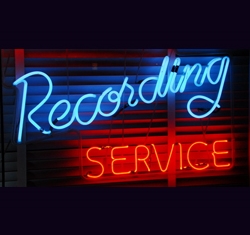
—- 1949, RCA Victor release the 7-inch 45 rpm record and player, while Columbia introduces the 12-inch 33-1/3 rpm record. Columbia will be the first manufacturer and record label to support all three formats (speeds) – 33-1/3, 45, 78.
Magnacord adds a second head to their PT-6 tape recorder, changing it from a mono to a stereo unit.
Willi Studer makes his very first tape machine, Dynavox, which later becomes a Revox. Frank McIntosh sells the first 50w1 Unity Coupled Amplifier that produces 50 watts at less then 1 percent distortion from 20 Hz – 20 kHz. This is easily noted as the year audio went “hi-fi.”
—- 1950, Muddy Waters records “Rollin Stone” in Chicago. In 1951, Sam Phillips records an Ike Turner song on an Ampex 350, sells the recording to Aristocrat Records, and starts Sun Records with the profit.
—- In 1953, Elvis begins work with Phillips at Sun Studios in Memphis, and a year later, records “That’s All Right” with Phillips using two Ampex 350 machines to create a slap back effect that will revolutionize rock ‘n roll recording and give Sun Studio a defining sound.
—- 1958, headphones are released to the world. Can we isolate instruments in the studio yet? (SHEESH!)
—- 1959, Sony shows first prototype of Helical scan machine.
—- 1963, Philips Company releases the compact audio cassette on 1/8-inch tape running at 1 7/8 ips.
—- 1969, Dolby noise reduction.
The research on this is becoming exhausting, and I’ve finally hit the era that most of us know the history of, to the current time. So let’s get to the point here. Since the inception of recorded audio, the inventors, builders and yes, users of the equipment have dedicated their lives to improving the equipment’s ability to record and reproduce audio.
For over 100 years, this community single-handedly shaped not only our culture, but more specifically, our lives as audio professionals. The line of acceptability used to be firmly defined.
Only in the last 20 years have we seen this trend roll off. It seems that as soon as we were able to “punch in” and fix mistakes made by the artist, technology quickly swooped in to remove the art and replace it with a new and improved “auto-fix-a-bad-take machines.”
As more and more studios started popping up, so did more and more gear manufacturers. Where once gear was custom-built for a studio, now it’s mass-assembled in places like Taiwan. We spend hours of our time discussing the best sounding microphones for the cheapest possible prices.
My simple question: When are the musicians so bad, and the recording equipment so poor, that you simply can’t make a good recording?
A few years ago, I would snicker every time I read Mercenary Audio’s ads that said, “Life’s too short to suck.” I regularly find myself typing, in an e-mail or on a forum, “You get what you pay for.”
A friend e-mailed me in the midst of a gear purchase and commented on how much time and frustration he could have saved himself if he would have just saved up the money for “good” gear to begin with.
As far as musicianship goes, I’m mixing a project right now that only the drummer should be playing on. The bass player is so off I thought the band might be coming off the sync head while the bass player was coming off the repro head. Both guitar players can’t hit a down beat to save their lives.
Can we please stop moving backward?
j. hall moderates the “Indie rock, in practice and in theory” forum in RE/P here at ProSoundWeb.
